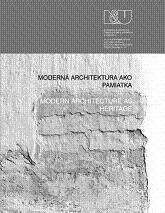LIEČEBNÝ DOM PALACE V SLIAČI – K OTÁZKE OBNOVY ARCHITEKTÚRY MEDZIVOJNOVÝCH SANATÓRIÍ
SPA HOUSE PALACE IN SLIAČ – ON THE QUESTION OF ARCHITECTURAL RESTORATION OF THE INTERWAR SANATORIA
Author(s): Veronika Kapišinská, Denis HaberlandSubject(s): Cultural Essay, Political Essay, Societal Essay
Published by: Historický ústav SAV, v. v. i.
Keywords: architecture; modern; spa; sanatorium; Rudolf Stockar; restoration; detail
Summary/Abstract: Architecture of sanatoria – convalescent hospitals in the twenties and thirties of the 20th century in the then Czechoslovakia, became well-known even outside the country. This is obvious from a considerable number of these buildings being declared national monuments, as well as their presence in the International Register of Modern Architecture DOCOMOMO. For decades, many of them kept the original looks and function almost untouched, nowadays, however, they are facing the pressure to upgrade the standards and modernize. Hence the issue of their renewal and continued use is more urgent with every passing year. It is also the case of the spa house named Palace in Sliač, designed by Prague architect Rudolf Stockar in the years 1925 – 1929 and 1932. Ever since its completion, it continually served the same purpose, which – hand in hand with ongoing maintenance – preserved the original character of this prominent spa facility just as well as most of the genuine atmosphere of the period for today’s guests. This site allows for an unusual opportunity nowadays to experience a typical functionalist buildings in an almost authentic state. Stringent requirements for ventilation and insolation of spa facilities present at the time of their designing represent a headache today in their preservation. Spa house Palace – which initially served as a seasonal facility with its abundance of vast glazed areas and roof terraces – poses a big problem in today’s renovation efforts, especially in terms of energy conservation. Combined with severe weather conditions on site, the question of usability and operation of the building while sustaining its original material setup under current energy requirements is highly problematic. Exceptionally extensive building such as the Palace spa house is also an example how important it is to seek supplementary functions for these facilities. Their full utilization would ensure sufficient funds for such an important national cultural heritage site for its proper and historically responsible restoration as well as its dignified survival while preserving its unique architectural design, detail and exceptional genius loci.
Journal: Architektúra & Urbanizmus
- Issue Year: 44/2010
- Issue No: 3-4
- Page Range: 310-325
- Page Count: 16
- Language: Slovak

